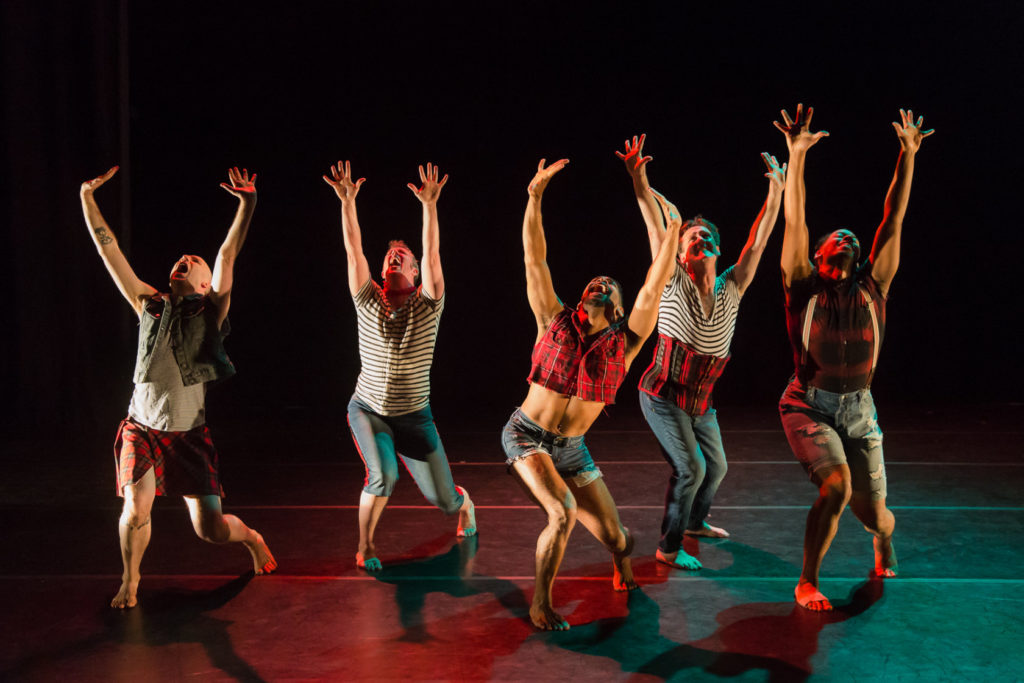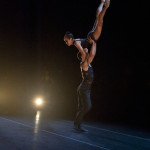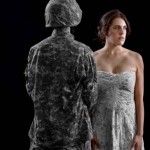Leigh Donlan reports from San Francisco’s Z Space:

Sean Dorsey Dance in Sean Dorsey’s BOYS IN TROUBLE (Photo: Kegan Marling)
Sean Dorsey Dance premiered Boys in Trouble Thursday night at San Francisco’s Z Space. In this dance-theatre exploration of masculine identity in queer and trans communities, transgender choreographer Dorsey (also one of the five male performers) wove tenderness and humor into the delicate narratives of what it means to be “a man” in contemporary American culture.
This production also addresses issues of bodily shame, self-loathing and topics that transcend gender and, in my humble opinion, would prove a healthy supplement to the K-12 curriculum.
Dorsey toured the country for two years, hosting forums on masculinity and teaching movement classes to queer and trans people. Drawing from this collective consciousness, he has gifted audiences with a deeply evolved perspective on the binary thinking of contemporary culture – this is male, this is not male; this is female, this is not female. The end of Act I culminates with the hilarious Butch vignette in which the male dancers vacillate between pseudo-macho embodiments, peacocking around the stage and aggressively posturing, and a softer embodiment of passive fluidity that could be considered stereotypically female – yet is it? These are some of the questions explored.

Sean Dorsey Dance in BOYS IN TROUBLE (Photo: Kegan Marling)
The most powerful duet, Sweet Time, was delivered in Act II by the company’s two black dancers, Arvejon Jones and Will Woodward. “People will see me as a black person first,” we hear Jones saying in a pre-recording. It begged the question: is transgender a “first world problem?” In a country founded on corrupt practices that were rooted in invasion, genocide, slavery and greed, currently presided over by a narcissist who boasts of grabbing women by their lady parts as a control tactic, Boys in Trouble attempts to cover a vast spectrum of critical issues, showing us how they are interconnected. What transpires is healing – amongst the dancers, the audience, and the wider community that in one way or another contributed to this imaginative and remarkable work.
Sweet Time provided the innocence lacking in American culturalization today. We watch Jones and Woodward explore relationship, as men, as black men, set against a backdrop of an eternal garden. At times we wonder if the interactions are sexual, at others times they feel parental. But by the end of the dance, full of difficult lifts and intricate partnering, we realize it doesn’t matter. What matters is the pure essence of their relationship. We are left without stereotypes and labels of their union because it is based on unconditional love.
And as the production winds down, we are also left considering our individual relationships with our own bodies. “This is my body; and my body is evidence of a singular determination to stay alive and thrive in a world that would rather I did not,” Dorsey’s words echo throughout the theatre, their impact reaching beyond the glow of a single spotlight into the darkness. In program notes, Dorsey writes “. . . we are in trouble because everything in our culture tells us to disconnect from our own bodies, disconnect from touching and loving each other, and seek validation in power ‘over,’ or in silencing others, or ourselves.”
Healing the trauma; expanding the narrowness. This is what we have come to expect from Sean Dorsey Dance.






